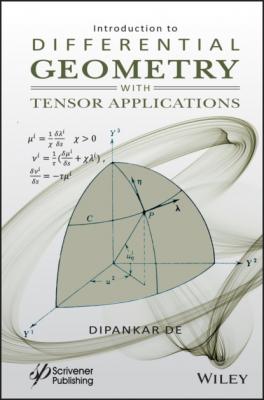Introduction to Differential Geometry with Tensor Applications. Группа авторов
Чтение книги онлайн.
Читать онлайн книгу Introduction to Differential Geometry with Tensor Applications - Группа авторов страница 11
 style="font-size:15px;"> Preliminaries
style="font-size:15px;"> Preliminaries
1.1 Introduction
Some quantities are associated with their magnitude and direction, but certain quantities are associated with two or more directions. Such a quantity is called a tensor, e.g., the stress at a point of an elastic solid is an example of a tensor which depends on two directions: one is normal and the other is that of force on the area. Tensor comes from the word tension.
In this chapter, we discuss the notation of systems of different orders, which are applied in the theory of determinants, symbols, and summation conventions. Also, results on some matrices and determinants are discussed because they will be used frequently later on.
1.2 Systems of Different Orders
Let us consider the two quantities, a1, a1 or a1, a2, which are represented by ai or ai, respectively, for i = 1, 2. In such cases, the expressions ai, ai, ai j, ai j, and
In a system of order zero, it is shown that the quantity has no index, such as a. The upper and lower indices of a system are called its indices of contravariance and covariance, respectively. For a system of
1.3 Summation Convention Certain Index
If in some expressions a certain index occurs twice, this means that this expression is summed with respect to that index for all admissible values of the index.
Thus, the linear form
Of course, the range of admissible values of the index, 1 to 4 in this case, must be specified. If the symbol i has a range of values from 1 to 3 and j ranges from 1 to 4, the expression
represents three linear forms:
(1.2)
Here, index i is the identifying (free) index and since index j, occurs twice, it is the summation index.
We shall adopt this convention throughout the chapters and take the sum whenever a letter appears in a term once in a subscript and once in superscript or if the same two indices are in subscript or are in superscript.
Example 1.3.1. Express the sum
Solution:
1.3.1 Dummy Index
The summation (or dummy) index can be changed at will. Thus, Equation (1.1) can be written in the form aikxk if k has the same range of values as j.
We will assume that the summation and identifying indices have ranges of value from 1 to n.
Thus, aixi will represent a linear form
For example,
So, any dummy index can be replaced by any other index with a range of the same numbers.
1.3.2 Free Index
If in an expression an index is not a dummy, i.e., it is not repeated twice, then it is called a free index. For example, for ai jxj, the index j is dummy, but index i is free.
1.4 Kronecker Symbols
A particular system of second order denoted by
(1.3)
Such a system is called a Kronecker symbol or Kronecker delta.
For example,
We shall now consider some properties of this system.
Property 1.4.1. If x1, x2, … xn are independent variables, then
(1.4)
Property 1.4.2. From the summation convention, we get
Similarly, δii = δii = n
Property 1.4.3. From the definition of δi j, taken as an element of unit matrix I, we have